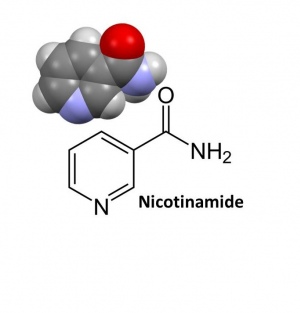New clinical trial reveals early promise for treatment for Friedreich's ataxia

Researchers have discovered Vitamin B3 may hold the key for treating the childhood degenerative disease Friedreich's ataxia
Friedreich’s ataxia is an inherited and progressive disease, which affects speech and movement and typically occurs during childhood. Within 10 to 20 years sufferers are confined to a wheelchair, before becoming completely incapacitated in later stages. Those with this debilitating condition require lifelong support and there is currently no treatment or cure.
The disease is caused by having abnormally low levels of a protein known as Frataxin due to partial inactivation of the Frataxin gene. In the first clinical trial of its kind, a team based at Imperial College London tested the ability of nicotinamide (a form of vitamin B3) to increase levels of frataxin. Vitamin B3 is an essential vitamin most commonly known for processing fat and proteins in the body. It can also inhibit the removal of activation ‘marks’ which occurs on the abnormally silenced Friedreich’s ataxia gene.
The research team tested the effect of increasing doses of nicotinamide to determine how well it was tolerated and its safety profile. Nicotinamide was generally well tolerated and was shown to increase levels of frataxin protein to the levels found in carriers without symptoms of the condition, when taken daily for up to 2 months. The patients received single and multiple doses of nicotinamide at doses much higher than used for vitamin supplementation.
These results are very encouraging and importantly offer the prospect of a future treatment for this incurable condition
– Professor Richard Festenstein
Clinical Professor of Molecular Medicine
Published in the Lancet, the research was led by Professor Richard Festenstein who is from the Department of Medicine at Imperial College London and an Associate of the MRC Clinical Sciences Centre. The trial is the continuation of previous research by Professor Festenstein, supported by Ataxia UK and the MRC, which showed that a nicotinamide-induced increase in frataxin levels was achievable in cells taken from patients and that the mechanism involved nicotinamide acting on the gene that causes Friedreich’s ataxia by ‘switching it back on’. The result is an increase in production of frataxin protein, and is thought to work by ‘opening up’ the gene making it accessible to the machinery which switches it on.
Professor Festenstein said: “These results are very encouraging and importantly offer the prospect of a future treatment for this incurable condition. Further studies are needed to determine the safety of high-dose nicotinamide with long-term administration and whether it can increase frataxin levels when given for longer periods. Then we need to know if this will prevent further clinical decline in patients with Friedreich’s ataxia. The study is also exciting because it provides proof-of-concept that aberrant gene silencing can be overcome in humans using an ‘epigenetic modifier’. This opens the way to a radical approach for other disorders caused by a similar mechanism.”
Dr Vincenzo Libri, Head of Clinical Studies at the NIHR/Wellcome Trust Imperial Clinical Research Facility, said: “Finding a cure for Friedreich’s ataxia is what every researcher in the field dreams about. We're absolutely thrilled by our preliminary results and the hope it offers for the future of patients with this devastating condition and their families. Our results help us understand the key elements of how nicotinamide may work and are important for translating the research from the laboratory into a clinical treatment. However, given the exploratory nature of our investigation, our results should be interpreted with caution and require further substantiation from larger confirmatory studies before we can make our vision of a cure a reality”.

Structure of Nicotinamide (vitamin B3) molecule
Dr Paola Giunti from University College London, who contributed to the design of the trial and to the recruitment of the patients through the Ataxia Centre run by her at the National Hospital for Neurology and Neurosurgery (UCL/UCLH), said: “We are excited by the prospects of nicotinamide potentially being developed into a treatment but it is important to remember that we still need to conduct further trials to confirm the safety over a longer time and to see whether the increase in frataxin actually results in improvements for patients. We are extremely grateful to all the patients who have taken part in this important pilot trial.”
Sue Millman, CEO of Ataxia UK added: “We are really proud to have supported the basic science for this hugely exciting trial and to have moved the research forward to a human trial with such positive early findings. This study was a truly collaborative effort involving ataxia charities in four countries and a number of other funding bodies all recognizing the importance of the study. We now need to push forward towards a larger trial which we hope can eventually be translated into a treatment for patients. That is our goal.”
The study was conducted at the NIHR/Wellcome Trust Imperial Clinical Research Facility, Imperial College Healthcare NHS Trust - Hammersmith Hospital.
This trial was funded by a grant from Ataxia UK in collaboration with three other ataxia charities worldwide namely Ataxia Ireland, Association suisse de l'Ataxie de Friedreich and Associazione italiana per la lotta alle sindromi atassiche. The research was also supported by the National Institute for Health Research (NIHR) Biomedical Research Centre based at Imperial College Healthcare NHS Trust and Imperial College London and the European Friedreich’s ataxia consortium for translational research. The views expressed are those of the author(s) and not necessarily those of the NHS, the NIHR or the Department of Health
Based on a press release by Ataxia UK
Reference: V. Libri et al. ‘ Epigenetic and neurological effects and safety of high-dose nicotinamide in patients with Friedreich’s ataxia: an exploratory, open-label, dose-escalation study’ The Lancet (2014) http://dx.doi.org/10.1016/S0140-6736(14)60382-2
Article supporters
Article text (excluding photos or graphics) © Imperial College London.
Photos and graphics subject to third party copyright used with permission or © Imperial College London.
Reporter
Franca Davenport
Communications and Public Affairs